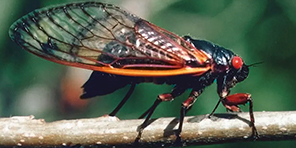LISLE, Ill.— Ahead of the historic spring 2024 emergence of periodical cicadas in Illinois, the tree experts at The Morton Arboretum are sharing tips on how to protect young and other vulnerable trees and shrubs from potential damage.
“While their noise and presence on sidewalks can be a nuisance, cicadas are not dangerous to people or a threat to healthy mature trees and shrubs,” said Stephanie Adams, the Arboretum’s plant health care leader. “But smaller young trees, as well as unhealthy older or stressed trees and shrubs, could suffer serious damage from the female cicadas’ egg-laying process.”
Large broods of cicadas will be found across an unusually wide area of the United States this spring, with both 13- and 17-year varieties emerging in May—something that occurs only every 221 years. Central and southern Illinois will experience 13-year cicadas, while 17-year cicadas will emerge in areas north of Springfield, including the Chicago region, southern Wisconsin and northwest Indiana. The two broods will overlap in a narrow band of central Illinois.
Periodical cicadas emerge in greater numbers than annual summer cicadas. Damage to trees occurs when female cicadas lay their eggs in small slits on twigs, made with a long, knife-like ovipositor. Heavily damaged twigs and small branches may wilt and break off. Some injured branches may not die the first year, but wounded areas will be weak sites that may eventually break off in a windstorm, Adams explained. In vulnerable trees and shrubs, the slits may not heal and could be entryways for canker diseases or other problems that could impact their future health and lead to further twig death.
“Healthy mature trees and shrubs, which can better tolerate cicada twig damage, typically experience some harmless natural pruning,” Adams said. “It is usually unnecessary to prune out any visible cicada damage on larger trees, as dead twigs will likely fall off and larger branches are unaffected.”
Adams provided these tips for protecting at-risk trees and shrubs before the cicadas emerge in May:
- Ensure that susceptible trees and shrubs are healthy in the spring. “Mulching, watering and addressing any disease problems they may have in the spring can help ensure they’re robust enough to sustain cicada damage,” Adams said.
- After leaves emerge, preferably when they are fully expanded and hardened off, and before the cicadas arrive, cover small trees and shrubs, including those with few developed branches, with a fine protective netting, such as tulle fabric. Close gaps in the netting with binder clips, clothespins or staples and gather the fabric around the trunk as near to the ground as possible. Once the emergence event is over, remove the netting.
- Consider waiting to plant young trees with a trunk diameter of less than 2 inches until after adult cicada activity has ceased, or in the fall.
- The Morton Arboretum recommends that homeowners not use insecticides against cicadas. Netting is the best protection for susceptible trees and shrubs, Adams said.
Despite their “yuck” factor, periodical cicadas bring some benefits for trees and plants, Adams said. “Cicada nymph exoskeletons and adult carcasses will function as fertilizer as they decay, and the carcasses also can be composted.”
For more expert tips about trees and cicadas, visit mortonarb.org/cicadas.

